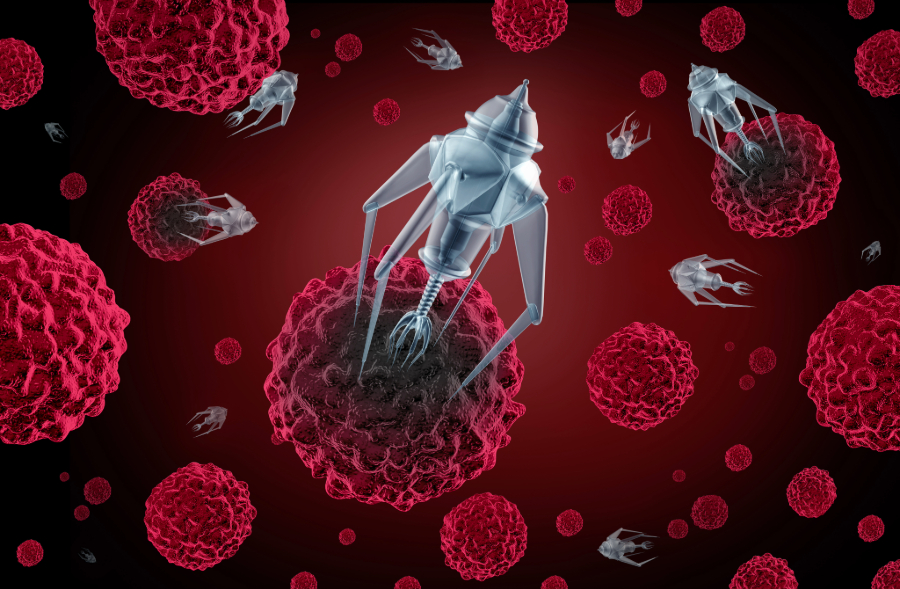Nanobots Future and Development
Nanobots are tiny, ~50–100 nm wide robots that perform a single, highly specialized task. They work incredibly well for administering drugs. Drugs typically act throughout the body before entering the diseased area. The medication can be precisely targeted with nanotechnology, increasing its effectiveness and lowering the possibility of negative side effects. Special sensor nanobots can be inserted into the blood under the skin where microchips, coated with human molecules and designed to emit an electrical impulse signal, monitor the sugar level in the blood.
According to estimates, nanotechnology will have a global net worth of more than $33.63 billion by 2030 as it continues to gain popularity. Even though a lot of nanotechnology initiatives are still in the research and development stages, scientists are making tremendous progress as they learn more about the potential applications of nanoparticles, including nanobots. The field of biomedicine is currently being disrupted by nanobots, or nanoscale robots, with specific breakthroughs happening in drug delivery and cancer diagnosis. Similar to the nanotechnology sector as a whole, the global market value of nanobots was estimated to be an astounding $5.3 billion in 2021, and this market is predicted to grow rapidly over the next ten years.
Types of Nanobots
Robert A. Freitas Jr. created the following kinds of nanobots as artificial blood:
- Respirocytes
- Microbivores
- Clottocytes
Respirocytes
Respirocytes are nanorobots designed as artificial mechanical red blood cells. They have a 1 m diameter and are round, blood-borne particles.
Microbivores
Microbivores are nanorobots, also referred to as nanorobotic phagocytes, which serve as artificial white blood cells. By using the phagocytosis process, microbivores primarily function to absorb and digest pathogens in the bloodstream.
Clottocytes
Nanorobotic artificial mechanical platelets (“clottocytes”) may allow for complete hemostasis in as little as one second 100 to 1000 times faster than the natural system and 10,000 times more effective in terms of bloodstream concentration. They could also work internally.
Examples of nanobots: Xenobots
The concept of xenobots, or nanorobots made of 500–1000 living cells and measuring less than 1 mm in length, has been made possible by recent research. They have been made in many simple forms, some of which have legs. According to studies, they can move small objects, interact with other xenobots to act collectively, move linearly or circularly, and survive for about ten days. Researchers think that the development of this type of nanorobot could have a beneficial effect on the health of people, animals, and the environment. But there are ethical questions because they are “programmable living robots” constructed from organic, living tissue.
Nanobots in Cancer Diagnosis
As of right now, the nanorobots can identify twelve distinct kinds of cancer cells. Medical treatment has been greatly expanded as a result of nanotechnology breakthroughs, and DNA nanobots are being used to identify various cancer cell types.
Precision Medicine with Nanobots
Researchers are examining whether DNA nanobots can eradicate cancer cells. By successfully programming DNA strands to travel through the blood to the tumor site, blood-clotting medications can be delivered to stop the tumor’s blood supply and growth. Numerous recent studies have emphasized how nanobots may be used in the future to deliver drugs. The present findings are encouraging, indicating that humans may soon be able to receive medication from nanobots with higher levels of precision and efficacy. The negative side effects of the treatments being used now might be lessened with this more effective delivery. Recently, a research team used optical microscopy and Positron Emission Tomography (PET) to visualize the movements of nanobots in vitro.
Building a “World Superbrain”
Using nanotechnology to create a “global superbrain”—a place where human thought could theoretically be transferred to an artificial interface—and create a human “brain-cloud interface” is a final intriguing development in nanobot research.
Can Daily Hygiene Routines Be Transformed by Nanobots?
Shortly, nanobots may be used to automate routine but necessary tasks like brushing one’s teeth. A shape-shifting robotic microswarm developed by researchers at the University of Pennsylvania has the potential to take the place of brushing, flossing, and rinsing.
The invention is based on self-assembling iron nanoparticles that, when exposed to a magnetic field, change form to fit the contours of teeth and gums. Next, pathogens are eliminated by free radicals produced by nanoparticles. Research has indicated that the technology is just as efficient as conventional brushing and flossing.
Source

